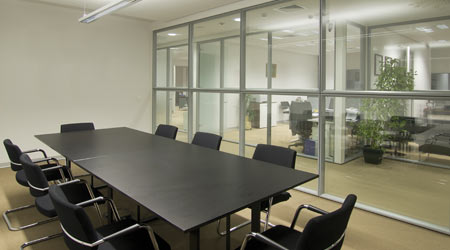 The ceiling, the walls, the floor, and the soundmasking system all play important roles in determining the acoustical quality of a space.
The ceiling, the walls, the floor, and the soundmasking system all play important roles in determining the acoustical quality of a space.How Soundmasking Leads to Better Acoustics, Pleasant Space
Thoughtfully designed soundmasking systems can solve many acoustical problems in office space. Here's what to consider to get soundmasking right.
“Most workplaces today feature more open spaces and smaller, and often shared, workstations,” says Berger. “Lower or non-existent partitions, hard or glass surfaces, and thinner walls and doors create acoustic challenges that negatively affect workplace satisfaction, productivity, and speech privacy.”
The solution, he says, often comes via soundmasking, a process by which low-level, specific-frequency sound is intentionally added to the space. It works by making the intelligibility of spoken voices lower.
Many soundmasking systems use speakers at or above ceiling height, which produce a sound similar to softly blowing air, says Niklas Moeller, vice president, LogiSon Acoustic Network. Many occupants presume HVAC is its source.
“Unlike HVAC, this sound is continuous and professionally tuned to meet a particular spectrum — or ‘curve’ — that’s engineered to balance acoustic control and occupant comfort,” he notes.
Some soundmasking systems can be placed under a raised access floor and produce sound that is radiated up into the workspace. These can be tuned to bounce sound off ceiling tiles for complete coverage in the workspace, says Berger.
Specifying soundmasking requires the help of consultants to properly meet balanced acoustic control in office space. Achieving this acoustic balance isn’t easy since multiple metrics — sound transmission class, articulation index, and signal-to-noise ratio — might be used to determine the appropriate soundmasking levels and frequencies.
Soundmasking doesn’t have to be employed solely in open spaces. In some instances, use of soundmasking in closed spaces also is a viable choice. When used in closed rooms, Moeller says, a best practice is to have each room on its own control zone for volume and frequency.
“Limiting open plan control zones to no more than three loudspeakers permits the sound produced in the space — a combination of the loudspeakers’ output and its interaction with the facility’s layout, furniture and finishings — to be finely adjusted or ‘tuned’ to an effective masking spectrum across the entire space,” Moeller says.
Be governed by need
Modern offices have zones of work space that often require separate and sometimes competing acoustical performance considerations, so facility managers need to make acoustical choices depending on how the space is being used. Inside of conference rooms, speech intelligibility should be high, while transmission of sound outside of the space should be blocked for privacy purposes. But for the bulk of office space — occupants at work stations and shared public spaces — speech intelligibility should be low.
Getting occupants to understand acoustic performance is also important. “So much of acoustics is having best performance practices,” says DeGrace. “It’s essential for occupants to understand how to use those spaces.”
It’s also essential to be specific and precise about aims for a space. “End users will say, imprecisely: ‘We have a noise problem,’ and takes a bit of time to unpack that sentiment,” Browne says.
Salenger notes that building use throughout a single day can also affect the choices made. For example, first thing in the morning, before a space truly comes up to tempo, different acoustical properties will be desired. “As the building activates in the morning, no sound masking is usually required,” she says.
The bottom line is that no facility wants occupants unproductive or uncomfortable in their space.
“It’s useful to think about the radius of distraction,” says Browne. “You’ll want to make material choices that don’t allow me to hear my neighbor’s neighbor in open office space.”
Loren Snyder, a contributing editor for Building Operating Management, is a writer who specializes in facility issues. He was formerly managing editor of Building Operating Management.
Email comments and questions to edward.sullivan@tradepress.com.
Related Topics:














